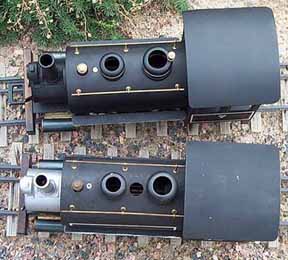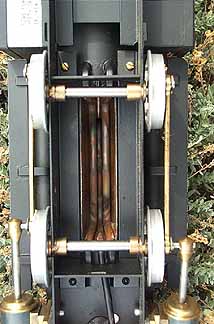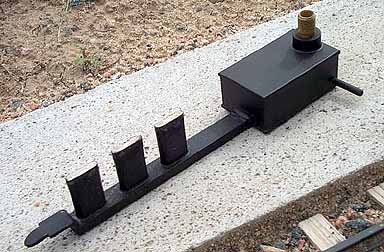
Back to Sidestreet Bannerworks
August 2000
Creekside Forge & Foundry's
Baldwin 0-4-0ST
by Marc Horovitz

Sometime in 1983 I began corresponding with Carlos Grundhoeffer of Palmyra, New York. Carl wanted to develop a steam locomotive along the lines of the (then) new Mamod, but featuring better construction and American styling. His letters over the next couple of years make fascinating reading, as they chronicle the development of a new steam locomotive, including all the trial and error, frustration, failures, and ultimate success of the project.
Carl was a reclusive fellow. He lived (so I was told) in an abandoned pickle factory. He had no phone. To speak to him, I had to call a friend of his down the road. This fellow would then drive to Carl’s and bring him back so that he could call me.
The first operating prototype reached my hands in early August, 1984. I had just completed my first garden railway (all 30’ of it) and it was on this line that the initial tests were made. I ran the locomotive several times with varying loads, noting the results, which I communicated to Carl. He offered suggestions and ideas for changes, many of which he ultimately incorporated into the production models. It was about this time that he also settled on a company name: Creekside Forge & Foundry.
The locomotive, which became known as the Creekside Baldwin, finally reached the market early in 1985, selling for $150. Demand was high, but production was low. Availability was a problem from the outset. Carl was a perfectionist and nothing left the factory that wasn’t top notch. Production problems continued to haunt him, and the locomotive ultimately faded from the scene only a year or so later, leaving many disappointed potential customers. It’s a pity, really. Carl’s letters indicated his intention of producing a whole range of gauge 0 and 1 locomotives in a variety of configurations. It’s too bad that the frustrations of bringing a single one to reality proved so draining.
Where is Carl today? How many engines were ultimately made? (I’d guess around 30.) Where is the tooling for them? I have no answers for these questions. If any of you readers have better information, please let me know.
The engine
As mentioned above, the Creekside Baldwin is based on Mamod technology. It has two, double-acting oscillating cylinders controlled (both speed and direction) by a rotary valve located between the frames, under the smokebox at the front of the engine. The boiler features a water glass similar to Mamod’s and, like the Mamod, it has no lubricator. It was offered in both gauge 0 and gauge 1 versions.
The Creekside’s boiler was a departure from the Mamod’s. It is an unusual design and could probably be considered internally fired, even though the fire is beneath it, as with a pot boiler. The boiler has a longitudinal vertical slot from top to bottom, wider at the bottom. Inside this slot are two water tubes and what amounts to a superheater tube.
The burner is a more-or-less traditional alcohol burner, except that the wick tubes are thin rectangles (see the picture) and use a ceramic-fiber material called Fiberfrax for wicking. The burner keys into the frame at the front end and can be quickly removed by unscrewing a nut inside the cab. There is also a screw-on cap on the alcohol tank.
Performance
The engine I fired up hadn’t been run in 10 or more years. I prepped it in the usual way, oiling all round, filling the boiler with distilled water, and the alcohol tank with fuel. Lighting up is straightforward. Because of the boiler design, the engine makes odd “clanking” sounds when steam is being raised.
Once steam was up, I opened the control valve and off it went. The locomotive will pull a moderate load, say two to three cars. This particular day, the temperature was in the 90s, which may have contributed to a spectacular run (for such a small engine) of nearly half an hour.
| Specifications | |
| Builder | Creekside Forge & Foundry |
| Date built | 1985 |
| Gauge | 45mm (pre-production prototype is 32mm) |
| Scale | 1:24 |
| Boiler | Semi-internally fired |
| Fittings | Safety valve, water glass |
| Fuel | Alcohol |
| Working pressure | 10 psi |
| Cylinders | Two, double-acting oscillators |
| Reversing gear | Rotary valve at front of locomotive, exchanges admission and exhaust |
| Duration | 20-25 minutes |
| Minimum radius | 2' |
| Dimensions | Length over end beams, 9.25"; width, 3.5"; height, 5.25" |





Back to Sidestreet Bannerworks
This page and its contents Copyright Sidestreet Bannerworks, 2000